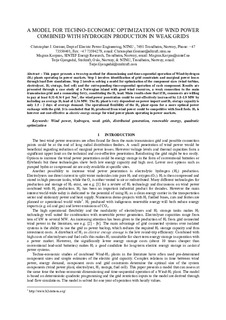A Model for Techno-Economic Optimization of Wind Power Combined with Hydrogen Production in Weak Grids
Journal article, Peer reviewed
Accepted version
Permanent lenke
http://hdl.handle.net/11250/2459231Utgivelsesdato
2009Metadata
Vis full innførselSamlinger
- Institutt for elkraftteknikk [2468]
- Publikasjoner fra CRIStin - NTNU [38127]
Originalversjon
EPE Journal : European Power Electronics and Drives Journal. 2009, 19 (2), 52-59. 10.1080/09398368.2009.11463717Sammendrag
This paper presents a two-step method for dimensioning and time-sequential operation of Wind-hydrogen (H2) plants operating in power markets. Step 1 involves identification of grid constraints and marginal power losses through load flow simulations. Step 2 involves solving a model for optimization of the component sizes (wind turbine, electrolyser, H2 storage, fuel cell) and the corresponding time-sequential operation of each component. Results are presented through a case study of a Norwegian island with good wind resources, a weak connection to the main transmission grid and a commuting ferry, constituting the H2 load. Main results show that if H2 consumers are willing to pay at least 0.31–0.34 € per Nm3, the wind power penetration could be cost-effectively increased by 1.8–1.9 MW by including an average H2 load of 1.36 MW. The H2 plant is very dependent on power import and H2 storage capacity is only 1.5–2 days of average demand. The operational flexibility of the H2 plant opens for a more optimal power exchange with the grid. It is concluded that H2 produced from wind power could be competitive with fossil fuels. H2 is however not cost-effective as electric energy storage for wind power plants operating in power markets.
